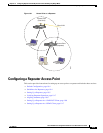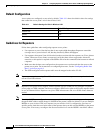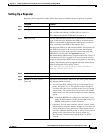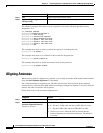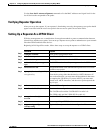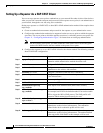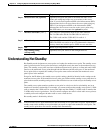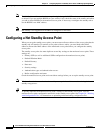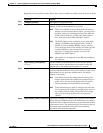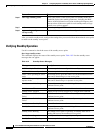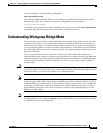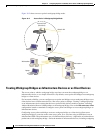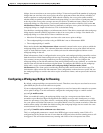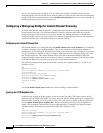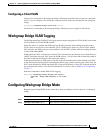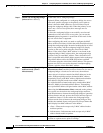
19-11
Cisco IOS Software Configuration Guide for Cisco Aironet Access Points
OL-30644-01
Chapter 19 Configuring Repeater and Standby Access Points and Workgroup Bridge Mode
Configuring a Hot Standby Access Point
Beginning in Privileged Exec mode, follow these steps to enable hot standby mode on an access point:
Command Purpose
Step 1
configure terminal Enter global configuration mode.
Step 2
iapp standby mac-address Puts the access point into standby mode and specifies the MAC
address of radio on the monitored access point.
Note When you configure an access point with two radios to
monitor an access point with two radios, you must enter
the MAC addresses of both the monitored 2.4-GHz and
5-GHz radios. Enter the 2.4-GHz radio MAC address
first, followed by the 5-GHz radio MAC address.
Note The MAC address of the monitored access point might
change if a BSSID on the monitored unit is added or
deleted. If you use multiple BSSIDs on your wireless
LAN, check the status of the standby unit when you add
or delete BSSIDs on the monitored access point. If
necessary, reconfigure the standby unit to use the
BSSID’s new MAC address.
Note Hot standby is not supported on the BR1410 configured
for AP mode.
Step 3
iapp standby poll-frequency
seconds
Sets the number of seconds between queries that the standby
access point sends to the monitored access point’s radio and
Ethernet ports. The default poll frequency is 2 seconds.
Step 4
iapp standby timeout seconds Sets the number of seconds the standby access point waits for a
response from the monitored access point before it assumes that
the monitored access point has malfunctioned. The default
timeout is 20 seconds.
Note You should increase the standby timeout setting if the
bridged path between the standby and monitored access
points can be lost for periods greater than 20 seconds
(during spanning tree recalculation, for example).
Note If the monitored access point is configured to select the
least congested radio channel, you might need to increase
the standby timeout setting. The monitored unit might
take up to 40 seconds to select the least congested
channel.
Step 5
iapp standby primary-shutdown (Optional) Configures the standby access point to send a Dumb
Device Protocol (DDP) message to the monitored access point to
disable the radios of the monitored access point when the standby
unit becomes active. This feature prevents client devices that are
associated to the monitored access point from remaining
associated to the malfunctioning unit.



